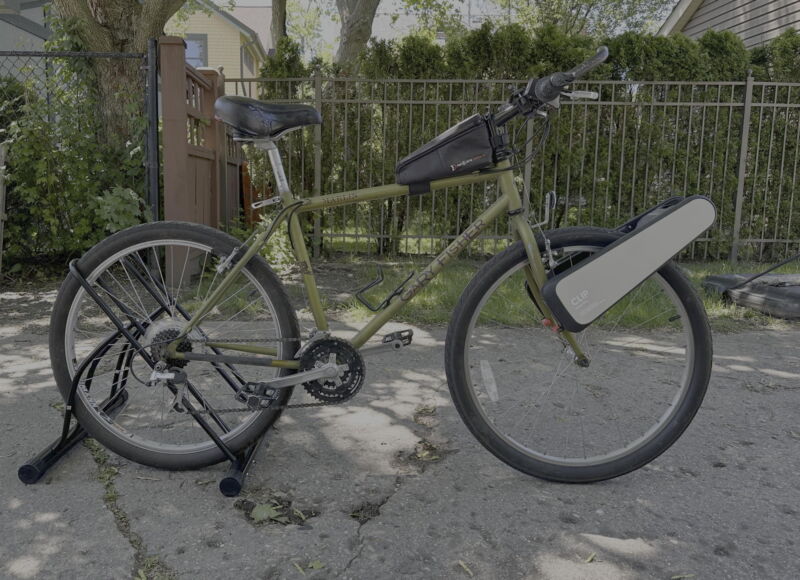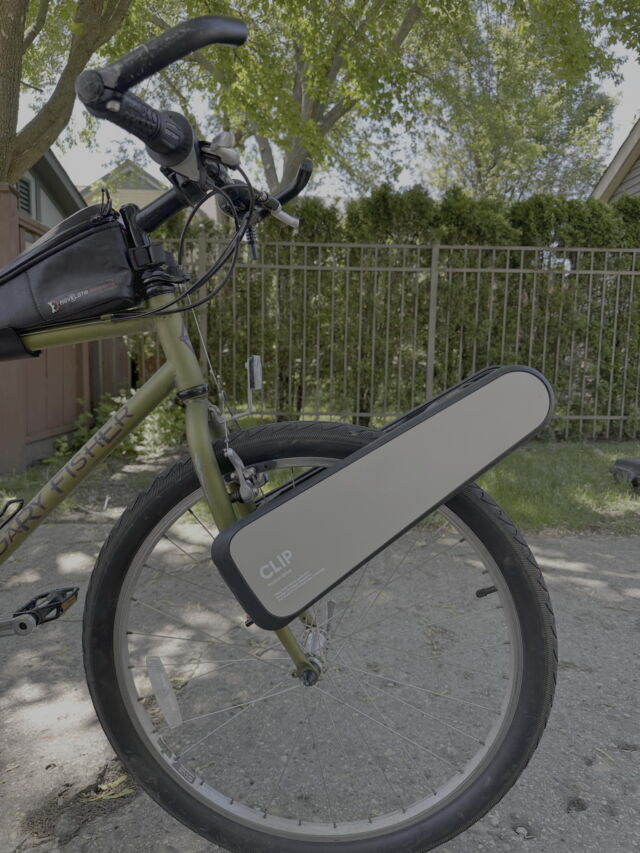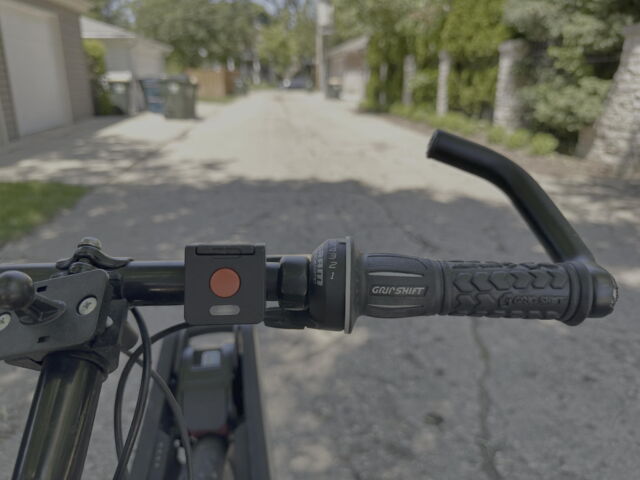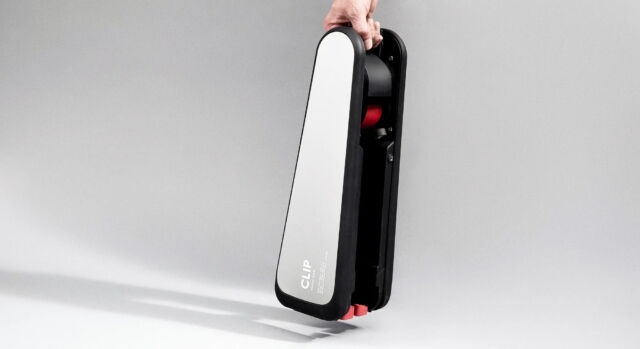Easy e-bike —
Dead simple to use, the Clip offers up to 12 miles of electric range for your bike.

Enlarge / The Clip attached to a late-90s vintage mountain bike.
Eric Bangeman
Shortly after World War II, a French manufacturer by the name of Solex started selling mopeds. These were not your “typical” moped that looks kind of like a motorcycle with pedals—the mopeds made by Solex were essentially bicycles with a small, two-stroke engine mounted over the front wheel that could propel the rider around 100 km on a single liter of gas mixture. The downside: Solex mopeds were loud and cumbersome to ride due to the weight distribution, and they never really caught on in North America.
Clip, a startup based in Brooklyn, New York, has come up with its own twist on the Solex. Its only product, the eponymously named Clip, is a friction drive unit that attaches to the front fork of any bicycle, turning it into an e-bike. At $499 for the Commuter model and $599 for the Explorer, it is a relatively inexpensive way to turn just about any bicycle into an e-bike for a fraction of the cost of a new one.

Enlarge / The Clip mounts to the front fork just below the brake caliper.
Eric Bangeman
Weighing in at 8.8 lb (4 kg) for the Commuter model (the Explorer is a pound heavier), the Clip is at its essence a portable friction-drive. There’s a detachable controller that mounts on the handlebar and the unit itself. The Explorer model, the one we reviewed, has a 192 Wh battery that takes an hour to fully charge. Its range is pegged at “up to 12 miles,” a claim that is pretty accurate based on our testing, and the top speed is 15 mph. The Commuter model offers half the battery capacity, charge time, and range.
Twelve miles may not seem like a lot, especially in contrast to e-bikes with ranges that exceed 70 miles. But the Clip isn’t designed for long, leisurely rides. It’s a tool for folks who want to resuscitate old bikes that might be gathering dust in the garage. In my case, that bike is a 1997 Gary Fisher Marlin mountain bike that is now only ridden once or twice a year.
Clipping the Clip to your bike
The Clip arrived in a box with a single sheet of instructions glued to the inside with a pair of QR codes. One leads to the product manual, but the other one has a surprising function: scheduling a one-on-one orientation session with Clip, which is unusual and fantastic at the same time. Mine took about 20 minutes.

Enlarge / The Clip remote. Hold the red button down to go; the white button below will regenerate the battery.
Eric Bangeman
In theory, attaching the Clip to a bike is simple, and it is fairly easy once you get the hang of it. First, remove the remote from the Clip, which attaches to the bicycle’s handlebar with a clever rubber loop. Next, grab one side of the Clip, slide the button on the handle, and push the handle forward. Then align the top edge so that it sits just below the brake caliper and pull down on the handle of the Clip. If you’ve done it right, you’ll hear a satisfying click, and the white LED battery charge indicators on the Clip will light up. The wheel of the Clip should now be resting on the front wheel of the bike, so congratulations—you now have an e-bike.

Enlarge / The view from the top.
Eric Bangeman
Operation is dead simple. Press and hold the red button to activate the friction drive. Press and hold the white button for some regenerative braking action. The lack of displays and apps means we have to take Clip’s word that the regen function can restore 12 to 18 percent of the device’s range. In practice, it acts as a low-key brake as it sends charge back to the battery.
Immediately after mounting, I found that I had to pedal for a second or two before a button press would register with the Clip. After that, it worked like a charm. Positioning the remote close to the grip worked the best, and I gradually got used to holding the button while pedaling. Remembering to switch to the regen button while slowing down was a bit harder.
The extra 10 pounds of gear attached to the front wheel messes with the weight distribution, leading to one or two “whoa” moments my first time riding with it attached. But I figured out how to handle the bike and its new center of gravity fairly quickly. If you’re feeling lazy, you don’t need to pedal at all, and the Clip will eventually get you moving around 15 mph. Start pedaling, and you’ll feel the Clip adding to your effort—unless the road is wet. The Clip works best on dry roads; leave it at home if it’s raining.

Enlarge / At the end of the ride, unmount the Clip and take it with you.
Clip
Once you’ve reached your destination, grab the handle, pull it back toward you, and remove the Clip from the bike. Drop the remote back into its spot, and carry the Clip with you.
There are loads of e-bike conversion kits to choose from, but I have a hard time imagining something easier to install and use. And that’s what makes the Clip such a good product—there’s no messing with tools, installing motors, and mounting batteries. The Clip literally clips to your bike and electrifies it. I wouldn’t use it for a trip to the grocery store because I wouldn’t want to lug the Clip up and down the aisles. But for quick trips or short commutes, it’s a fantastic way to give new life to an old bike.